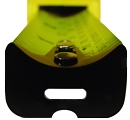What specifically should I look for in a tape measure blade?
Buy This Article Now!
 I'm shopping for a new tape measure and am somewhat frustrated by all the different types of tape measures on the market. Some have skinny blades; some have wide blades. What specifically should I look for in a tape measure blade? I'm shopping for a new tape measure and am somewhat frustrated by all the different types of tape measures on the market. Some have skinny blades; some have wide blades. What specifically should I look for in a tape measure blade?
 The basic rule when purchasing a tape measure is to select one that is comfortable in your hand. That's something only you can judge. The basic rule when purchasing a tape measure is to select one that is comfortable in your hand. That's something only you can judge.
Tape measure blades come in different lengths, widths, thicknesses, and finishes and display different styles of increments and markings. The length, width, and thickness of the blade determine the size of the case, which is really a shell to house the blade spool. The longer the blade, the larger the case and the heavier the tape measure.
The two most common blade widths are 3/4-inch and 1-inch, and the three most common blade lengths are 16 feet, 20 feet, and 25 feet. You'll want to select a tape length most appropriate for the types of projects you will be using it on.
 Tape measure blades come in two types of finishes: satin or gloss. They have a concave design, from a semi-inward curve to a heavy one, as shown in the image to the right. This inward curve helps to strengthen the blade so it remains stiff when extended to long vertical or horizontal lengths without support. Once the blade is extended beyond its designed strength, it will
either twist and/or bend, depending on the position of the blade (vertical
vs. horizontal). Tape measure blades come in two types of finishes: satin or gloss. They have a concave design, from a semi-inward curve to a heavy one, as shown in the image to the right. This inward curve helps to strengthen the blade so it remains stiff when extended to long vertical or horizontal lengths without support. Once the blade is extended beyond its designed strength, it will
either twist and/or bend, depending on the position of the blade (vertical
vs. horizontal).
Holding the tape blade in a vertical position, you should be able to walk (push) a 1-inch blade up a wall about 12 feet before the blade twists and bends; a 3/4-inch blade can be walked about 9 feet.
In a horizontal position, a 1-inch blade pulled out at an upward angle of 15 degrees should extend about 7 to 8 feet before it bends; a 3/4-inch blade will extend about 5 feet before it bends.
These measurements apply to a blade with a quality design. A thin blade will twist and/or bend at least 1 foot or more sooner than the measurements given above.
|
Once you finally settle on the right tape measure that fits you—the next step is understanding how to use it effectively so it can do the work for you.
To really learn the ins and outs of reading a tape measure and to gain insights into choosing the best one for you, consider purchasing my award-winning article, "Learn How to Read and Choose a Tape Measure." This article received the 2008 Vaughan/National Association of Home and Workshop Writers (NAHWW) Golden Hammer Writing Award in the Internet Category.
Available in both .pdf and hard copy, this 8-page article features 21 color photographs and provides outstanding information about using a tape measure to its full potential and purchasing a quality tape measure.
Click here to read customers' feedback. To purchase "Learn How to Read and Choose a Tape Measure," click here!
|
Copyright ©
2008 LAF/C.R.S., Inc. All rights reserved.
Question answered by Leon A. Frechette.
[ Back to Top ]
|


